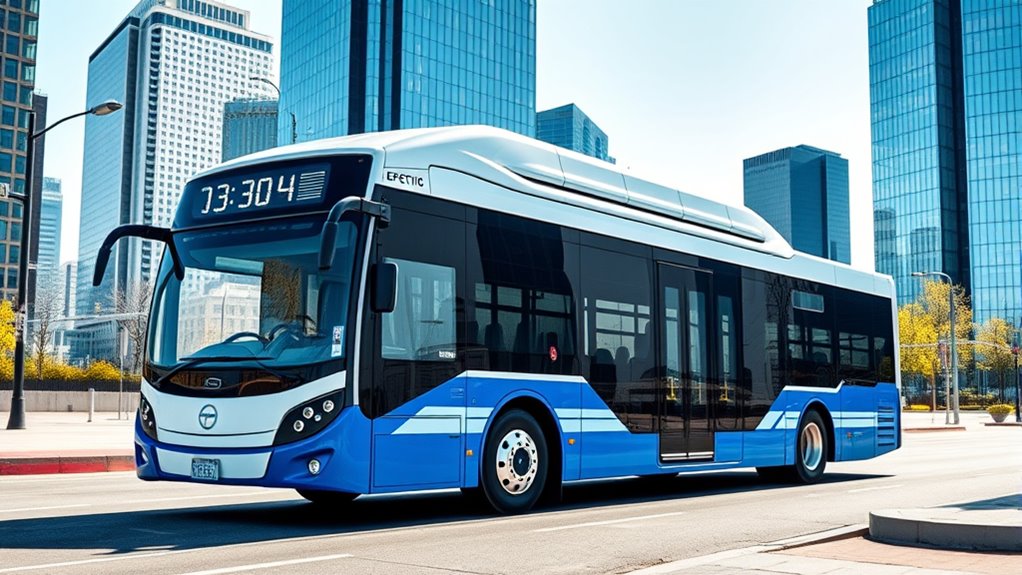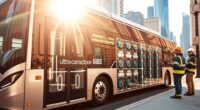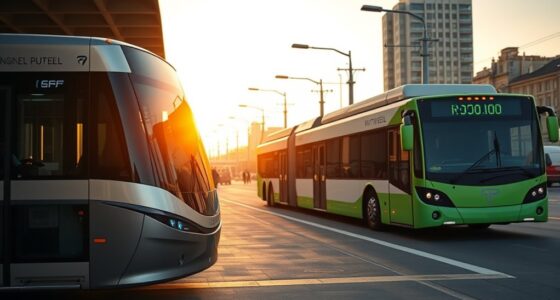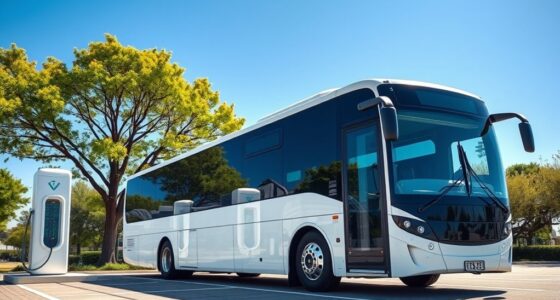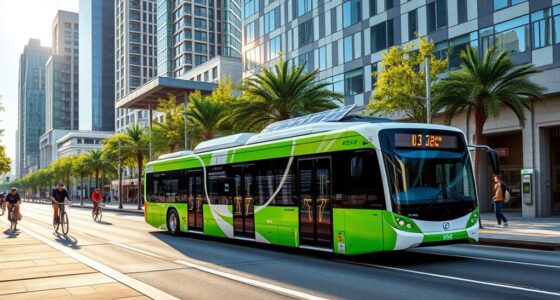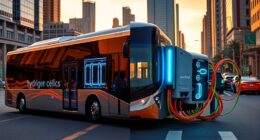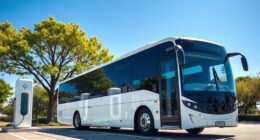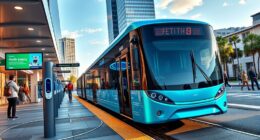Advancements in battery tech, like lithium-ion, solid-state, and lithium-sulfur batteries, boost electric bus range and safety. vehicle designs now incorporate smarter energy use, regenerative braking, and AI route planning, increasing efficiency by about 20%. New models often reach over 250 miles per charge. With ongoing innovations and supportive policies, the efficiency of electric buses is rapidly improving. Keep exploring to discover how these advancements are shaping more sustainable and cost-effective transit systems worldwide.
Key Takeaways
- Lithium-ion and solid-state batteries have increased energy density, enabling electric buses to reach over 250 miles per charge.
- Lithium-sulfur batteries offer higher energy capacity and longer lifespan, boosting overall bus range.
- Smarter energy management, AI route planning, and regenerative braking improve efficiency and extend battery life.
- Technological innovations reduce energy consumption by approximately 20%, enhancing operational efficiency.
- Regional deployment benefits from tailored solutions and infrastructure upgrades, optimizing performance and range.
Growing Market and Segmentation Trends
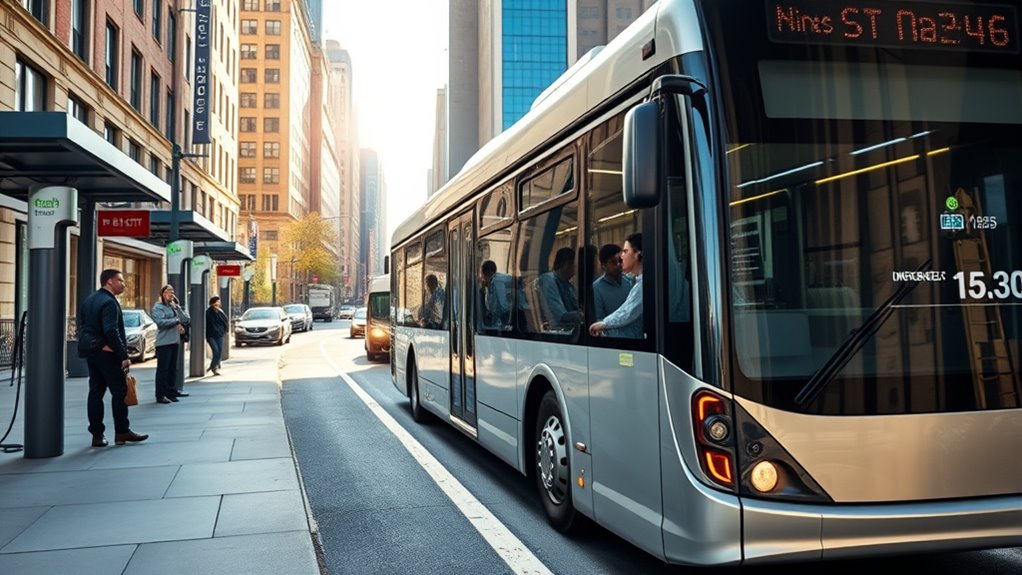
The electric bus market is experiencing rapid growth, driven by increasing environmental concerns and supportive government policies. You’ll see the market size soaring, with projections reaching USD 187.8 billion by 2032 and a compound annual growth rate of 14.2% from 2024.
The share of electric buses in total bus fleets is rising steadily, hitting nearly 4% in 2023. Governments worldwide encourage adoption through subsidies and tax incentives, accelerating this trend. As the industry evolves, staying informed about market trends can help stakeholders anticipate future developments. Additionally, advances in battery technology are crucial for improving vehicle range and charging times, further stimulating market expansion. Incorporating ESG considerations into investment decisions is also becoming increasingly important for aligning with global sustainability goals.
As a result, electric buses are becoming a significant segment within public transportation, especially in regions like Europe and Asia Pacific. Major players are forming strategic partnerships, expanding production, and customizing solutions for different markets.
This dynamic segmentation guarantees that electric buses aren’t only growing in numbers but also diversifying to meet regional demands. Monitoring industry growth can provide insights into future market shifts and innovations.
Technological Breakthroughs in Battery and Vehicle Design
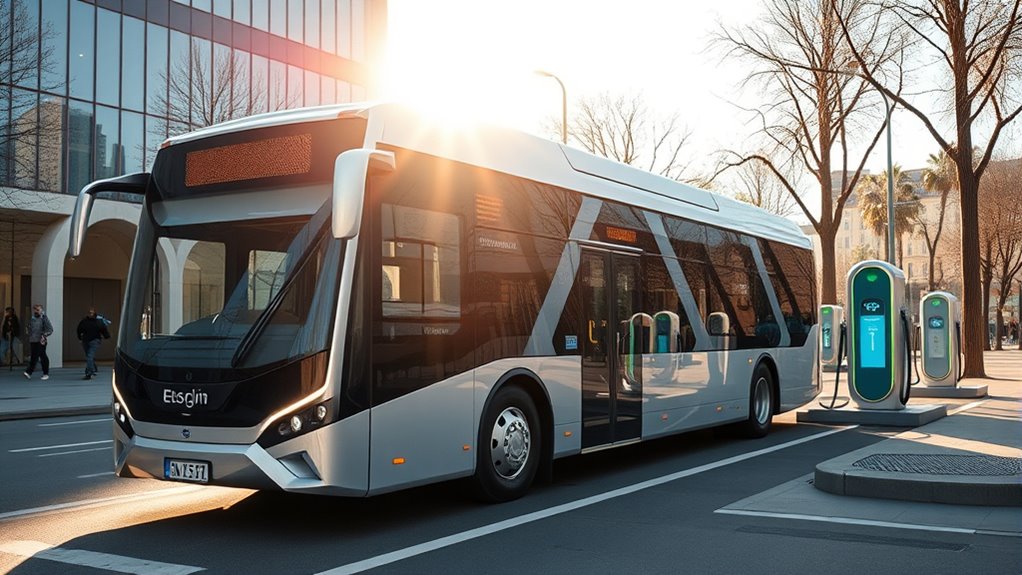
Recent advancements in battery and vehicle design are driving significant improvements in electric bus performance. Enhanced energy density from lithium-ion and solid-state batteries enables longer ranges and quicker recharges.
Recent battery and vehicle innovations boost electric bus range and efficiency significantly.
Solid-state batteries offer safer operation by reducing thermal risks, while lithium-sulfur variants boost energy capacity and lifespan. Battery management systems monitor performance to ensure safety and efficiency.
On the vehicle side, efficiency has increased by about 20% over three years, thanks to smarter energy use and AI-powered route planning. Advanced powertrain designs optimize performance, and vehicle structures are refined to lower energy needs without sacrificing capacity.
New bus models now routinely reach over 250 miles—about 25% more than earlier versions—making electric buses more reliable, cost-effective, and suited for wider deployment.
Government Policies and Incentives Accelerating Adoption
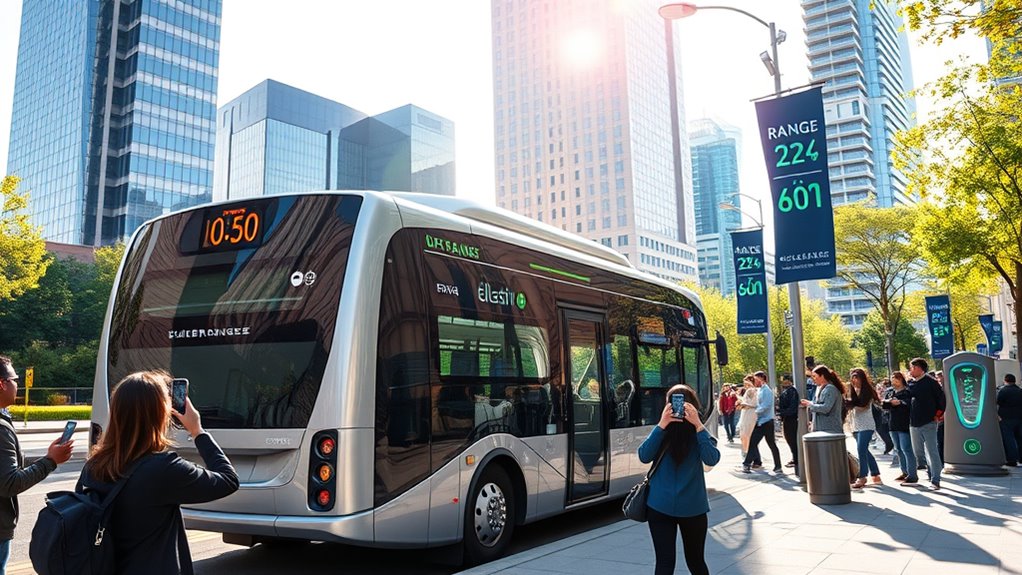
Government policies and incentives are fueling the rapid adoption of electric buses by lowering financial barriers and expanding supportive infrastructure. Grants and subsidies reduce upfront costs, making electric buses more competitive with diesel options. Additionally, the availability of sustainable materials in manufacturing supports environmental goals and appeals to eco-conscious agencies.
Investments in charging stations, along with programs like the VW Mitigation Trust and utility rebates, ease infrastructure development. Emission regulations, such as California’s Innovative Clean Transit, mandate zero-emission bus purchases, pushing transit agencies toward electric fleets. Infrastructure development is further supported by planning for future expansion to meet increasing demand.
Furthermore, integrating innovative storage solutions can optimize space and enhance charging capabilities at transit facilities.
These policies also promote public health by improving air quality and provide economic incentives, including tax benefits and subsidies, further encouraging adoption.
As a result, demand for electric buses has surged, prices have become more competitive, and infrastructure expansion has accelerated, creating a more conducive environment for widespread electric bus deployment nationwide. Vertical storage solutions and other space-maximizing strategies can further support the integration of charging infrastructure in transit facilities.
Market Growth Projections and Future Opportunities
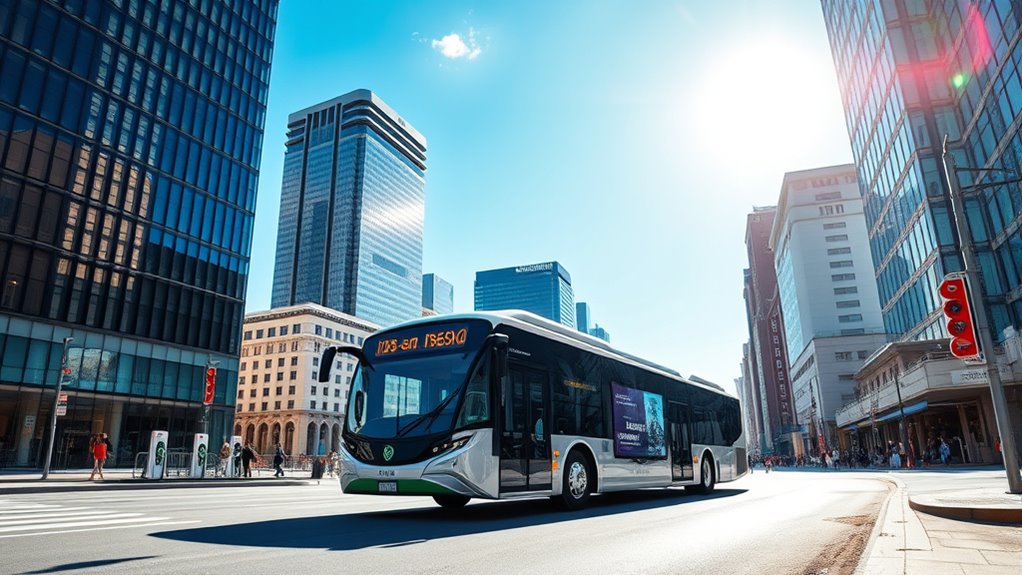
As policies and incentives accelerate electric bus adoption, the market’s growth prospects become increasingly promising. By 2030, the global market could reach $37.5 billion, with unit sales surpassing 1 million buses, driven by an expected CAGR of around 14-18%. Asia Pacific currently dominates with nearly 98% market share, but North America is projected to see the fastest growth due to strong policy support and fleet electrification efforts. Advancements in battery technology, particularly for long-range models, and decreasing component costs are key drivers. Additionally, new opportunities like second-life batteries, modular charging infrastructure, and intercity routes are emerging. These trends suggest a robust future, with significant investments and innovations shaping the electric bus landscape worldwide. Market growth is expected to continue accelerating as technological and policy developments support widespread adoption. Enhanced fraud prevention tools in transaction processing are also making digital payments more secure, which can facilitate seamless financing options for electric bus purchases. Moreover, ongoing improvements in Etsy SEO strategies can help manufacturers and service providers better reach their target audiences and capitalize on this expanding market.
Enhancing Operational Efficiency and Cost Benefits
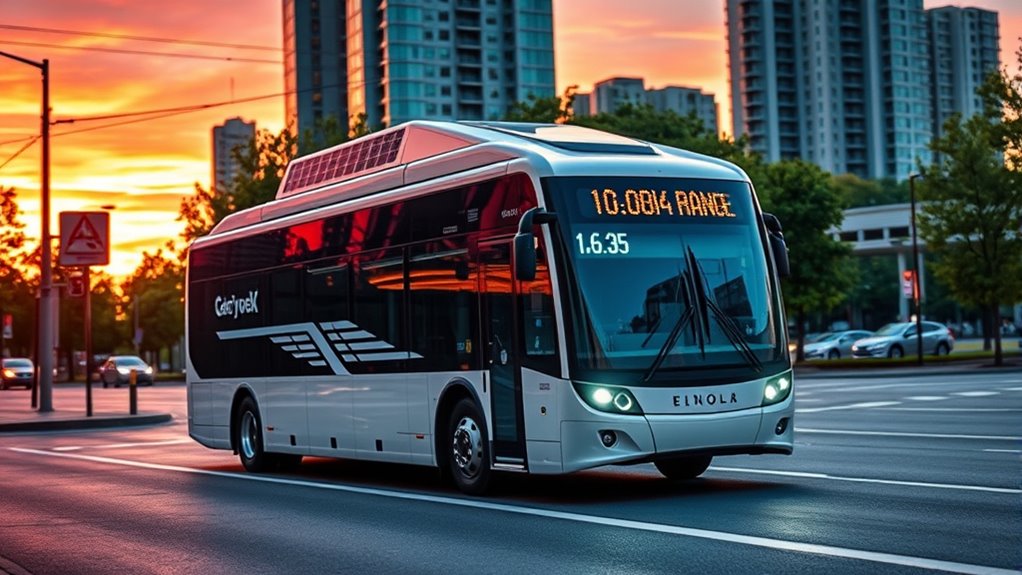
Optimizing operational efficiency and reducing costs are essential for maximizing the benefits of electric buses. You can achieve this by using real-time data and vehicle dynamics to forecast energy consumption accurately, allowing you to plan routes that stay within energy limits and prevent unexpected downtime.
Strategically placing charging stations based on energy models cuts infrastructure costs and boosts route efficiency. Dynamic adjustments to routes and schedules, responding to traffic or weather, help maintain ideal energy use.
Predictive maintenance detects issues early, reducing costly repairs and extending battery life, which saves money long-term. Additionally, regenerative braking captures energy during stops, enhancing efficiency. Incorporating heat pump technology in maintenance facilities can further improve energy efficiency and sustainability.
Furthermore, understanding growing and harvesting chia seeds can inform sustainable practices that reduce resource consumption and promote eco-friendly operations. Leveraging data analytics and smart technologies ensures your fleet operates reliably and cost-effectively, making electric bus systems more sustainable and economically viable.
Regional Dynamics and Infrastructure Development

Regional dynamics substantially influence the adoption and development of electric bus infrastructure worldwide. In some areas, like China, massive infrastructure plans, such as over 600,000 charging stations by 2025, support rapid e-bus growth.
You’ll find that countries like India and those in Europe are also investing heavily, with schemes like India’s FAME II and European bank funding. However, challenges remain; inadequate charging stations, grid capacity issues, and high infrastructure costs can hinder progress.
Effective planning is key—integrating vehicle procurement with infrastructure and operational strategies ensures efficient deployment. You must consider regional factors, such as government incentives and technological advancements, which shape how quickly and smoothly electric buses are adopted in different areas.
Additionally, understanding regional cost and budgeting considerations can help optimize resource allocation and ensure sustainable expansion of electric bus networks. Incorporating regional infrastructure development strategies can further accelerate adoption and improve overall system resilience. Recognizing regional technological readiness can help tailor solutions to specific areas, avoiding unnecessary delays.
Being aware of regulatory frameworks can also facilitate smoother implementation and compliance, ultimately supporting more efficient deployment. These dynamics directly impact your ability to implement successful, scalable electric bus networks.
Frequently Asked Questions
How Do Electric Buses Handle Extreme Weather Conditions Affecting Range?
You might wonder how electric buses handle extreme weather affecting their range. In cold conditions, they use thermal management systems to keep batteries warm and reduce energy drain, but range can decrease by up to 33%.
To counteract this, operators plan routes carefully, and some buses use external heaters.
In hot weather, cooling systems are used, though they also reduce overall efficiency. Proper planning and technology help maintain operational performance.
What Are the Key Challenges in Scaling up Charging Infrastructure Globally?
Think of scaling charging infrastructure like trying to send a telegram in the digital age. You face high costs and investment hurdles, limited infrastructure in many regions, and land constraints.
Coordinating charging stations with routes and managing grid capacity add complexity. Plus, inconsistent policies and evolving technology demand flexible, innovative solutions.
To succeed, you need strategic planning, public-private partnerships, and standardization to overcome these widespread challenges and accelerate adoption globally.
How Do Different Battery Chemistries Impact Bus Longevity and Safety?
You’ll find that different battery chemistries considerably impact bus longevity and safety.
LFP batteries, for instance, offer longer lifespan and better thermal stability, making them safer and more durable.
NMC batteries provide higher energy density but may not last as long and pose some safety risks like thermal runaway.
LTO batteries enable fast charging and high safety, especially for short routes.
Choosing the right chemistry depends on balancing safety, longevity, and operational needs.
What Innovations Are Improving the Sustainability of Electric Bus Manufacturing?
Did you know that electric bus manufacturing is increasingly eco-friendly? You can see this through innovations like green supply chains and recycling efforts, which cut waste and reduce environmental impact.
Companies are also integrating solar power into charging stations, decreasing reliance on fossil fuels. By adopting energy-efficient facilities and using sustainable materials, you help lower carbon footprints and promote cleaner urban air, making electric buses more sustainable from production to operation.
How Are Fleet Operators Managing Maintenance and Training for Electric Buses?
You’re managing maintenance and training by leveraging specialized programs from manufacturers and external organizations. You guarantee technicians are trained on high-voltage systems and advanced repairs, often through proprietary or OEM-led courses.
Using data analytics and real-time monitoring, you optimize maintenance schedules and fleet performance.
Smart charging and energy tracking help reduce costs, while scalable management systems support fleet growth.
These strategies keep your electric buses running efficiently and safely.
Conclusion
As the electric bus industry accelerates, embracing innovative insights and infrastructure investments, you’ll witness remarkable results in range and reliability. By harnessing heightened hardware, harnessing helpful policies, and honing your operational efficiency, you can propel progress and profit. So, stay savvy, seize the soaring opportunities, and support sustainable transportation solutions. Together, you’ll shape a cleaner, cost-effective commute that’s compactly composed of cutting-edge clean energy!
